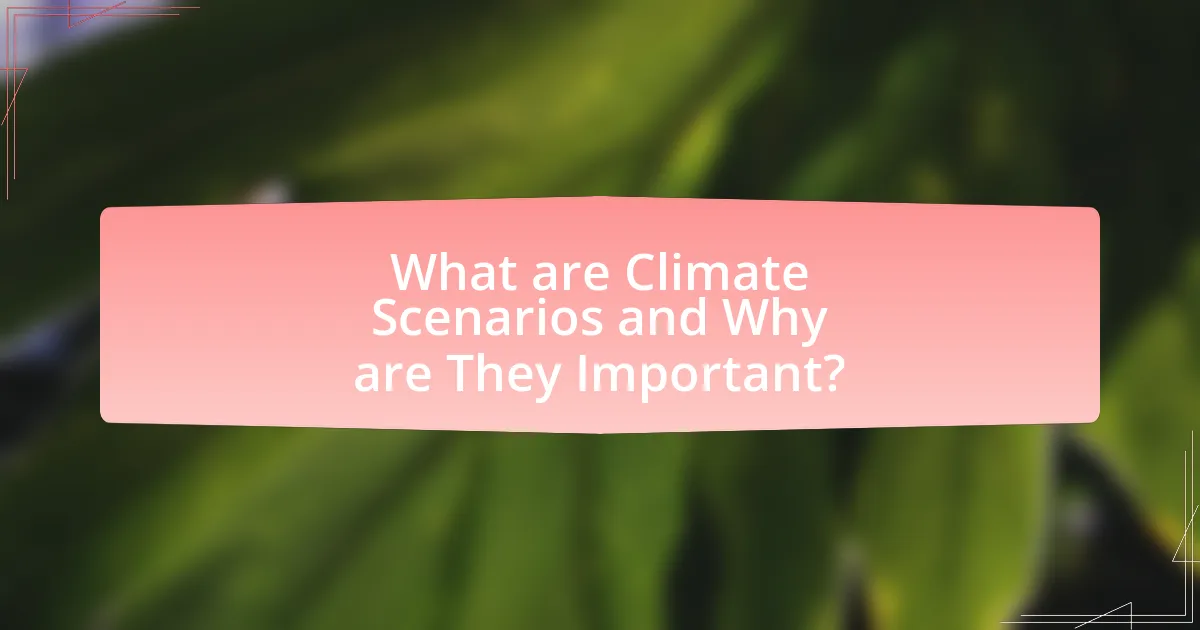Climate scenarios are structured narratives or models that project potential future climate conditions based on various assumptions regarding greenhouse gas emissions, land use, and socio-economic factors. This article examines the significance of climate scenarios in informing policymakers and stakeholders about possible climate outcomes, assessing risks, and developing strategies for mitigation and adaptation. It discusses key elements that define climate scenarios, the techniques used for simulation, and the challenges faced in accurately modeling future climate impacts. Additionally, it highlights the role of socio-economic factors, data integration, and collaborative efforts among scientists in enhancing the reliability of climate projections.

What are Climate Scenarios and Why are They Important?
Climate scenarios are structured narratives or models that project potential future climate conditions based on varying assumptions about greenhouse gas emissions, land use, and socio-economic factors. They are important because they help policymakers, scientists, and stakeholders understand the range of possible climate outcomes, assess risks, and develop strategies for mitigation and adaptation. For instance, the Intergovernmental Panel on Climate Change (IPCC) utilizes scenarios to inform global climate assessments, guiding international climate agreements and local planning efforts.
How do climate scenarios help in understanding future climate impacts?
Climate scenarios help in understanding future climate impacts by providing structured projections of potential climate conditions based on varying levels of greenhouse gas emissions and socio-economic developments. These scenarios enable researchers and policymakers to assess the range of possible climate outcomes, such as temperature increases, sea-level rise, and extreme weather events, which are critical for planning and adaptation strategies. For instance, the Intergovernmental Panel on Climate Change (IPCC) uses Representative Concentration Pathways (RCPs) to illustrate different emission trajectories, allowing for the evaluation of impacts on ecosystems, human health, and infrastructure under various future conditions. This structured approach facilitates informed decision-making and risk management in response to climate change.
What are the key elements that define a climate scenario?
Key elements that define a climate scenario include greenhouse gas emissions trajectories, climate sensitivity, socio-economic factors, and technological developments. Greenhouse gas emissions trajectories outline potential future emissions based on various policy and behavioral choices, while climate sensitivity refers to the temperature response of the climate system to increased greenhouse gases. Socio-economic factors encompass population growth, economic development, and land use changes, which influence emissions and vulnerability. Technological developments involve advancements in energy efficiency and renewable energy, impacting future emissions and adaptation strategies. These elements are critical for modeling and predicting climate impacts, as evidenced by the Intergovernmental Panel on Climate Change (IPCC) reports, which utilize these factors to project future climate conditions.
Why is it crucial to simulate various climate scenarios?
Simulating various climate scenarios is crucial for understanding potential future impacts of climate change. These simulations allow scientists and policymakers to assess risks, evaluate adaptation strategies, and inform decision-making processes. For instance, the Intergovernmental Panel on Climate Change (IPCC) utilizes multiple climate models to project temperature increases and their effects on ecosystems and human systems, providing a range of possible outcomes based on different greenhouse gas emission trajectories. This approach helps in identifying vulnerabilities and developing targeted responses to mitigate adverse effects, thereby enhancing resilience against climate-related challenges.
What types of climate scenarios are commonly used?
Commonly used climate scenarios include Representative Concentration Pathways (RCPs), Shared Socioeconomic Pathways (SSPs), and Integrated Assessment Models (IAMs). RCPs, such as RCP 2.6, RCP 4.5, RCP 6.0, and RCP 8.5, represent different greenhouse gas concentration trajectories and are utilized in climate modeling to project temperature increases and impacts. SSPs provide narratives about future socioeconomic developments that can influence emissions and adaptation strategies, while IAMs integrate knowledge from various disciplines to assess the interactions between climate change and socioeconomic factors. These scenarios are essential for informing climate policy and understanding potential future climate conditions.
What distinguishes qualitative from quantitative climate scenarios?
Qualitative climate scenarios focus on descriptive narratives and subjective assessments of potential future climate impacts, while quantitative climate scenarios rely on numerical data and statistical models to project specific outcomes. Qualitative scenarios often explore human experiences, values, and uncertainties, providing context and insights into potential climate responses. In contrast, quantitative scenarios utilize mathematical frameworks to generate measurable predictions, such as temperature changes or sea-level rise, based on empirical data and established climate models. This distinction is crucial for understanding the different approaches to climate scenario development and their respective applications in policy-making and research.
How do Representative Concentration Pathways (RCPs) function in climate modeling?
Representative Concentration Pathways (RCPs) function in climate modeling by providing standardized scenarios that represent different greenhouse gas concentration trajectories over time. These pathways allow researchers to simulate and analyze potential climate outcomes based on varying levels of emissions and land use changes. For instance, RCP 2.6 represents a scenario where global warming is limited to 2 degrees Celsius, while RCP 8.5 corresponds to a high-emission scenario with significant warming. The use of RCPs facilitates the comparison of climate impacts across different scenarios, enabling policymakers and scientists to assess risks and develop strategies for mitigation and adaptation.

What Techniques are Used to Simulate Future Climate Scenarios?
Techniques used to simulate future climate scenarios include climate modeling, scenario analysis, and statistical downscaling. Climate modeling involves using complex mathematical representations of the Earth’s climate system to predict future conditions based on various greenhouse gas emission scenarios. Scenario analysis examines different potential futures by altering variables such as population growth and technological advancements, allowing researchers to explore a range of outcomes. Statistical downscaling refines large-scale climate model outputs to provide localized climate projections, enhancing the relevance of predictions for specific regions. These techniques are validated through historical climate data comparisons and peer-reviewed studies, ensuring their reliability in forecasting future climate conditions.
How do climate models operate in simulating future scenarios?
Climate models operate by using mathematical equations to represent the physical processes of the Earth’s climate system, allowing them to simulate future scenarios based on various input parameters. These models incorporate data on atmospheric conditions, ocean currents, land surface processes, and greenhouse gas emissions to project potential climate changes over time. For instance, the Coupled Model Intercomparison Project (CMIP) provides standardized protocols for climate models, enabling comparisons and improvements in predictive accuracy. By running simulations under different greenhouse gas emission scenarios, such as those outlined in the Intergovernmental Panel on Climate Change (IPCC) reports, researchers can assess potential temperature increases, precipitation patterns, and extreme weather events, thus validating the models against historical climate data to ensure reliability.
What are the differences between global and regional climate models?
Global climate models (GCMs) simulate climate patterns on a planetary scale, while regional climate models (RCMs) focus on smaller, localized areas. GCMs operate with a coarse spatial resolution, typically ranging from 100 to 300 kilometers, which limits their ability to capture fine-scale climate features. In contrast, RCMs provide higher resolution, often down to 10 to 50 kilometers, allowing for more detailed representations of local climate phenomena such as topography and land use effects. This difference in resolution enables RCMs to better simulate extreme weather events and localized climate impacts, which GCMs may overlook due to their broader averaging. Additionally, GCMs are primarily used for long-term climate projections, while RCMs are often employed for short-term climate assessments and impact studies, making them complementary tools in climate research.
How do climate models incorporate various environmental factors?
Climate models incorporate various environmental factors by utilizing complex mathematical equations that simulate the interactions between the atmosphere, oceans, land surface, and ice. These models integrate data on temperature, precipitation, greenhouse gas concentrations, and land use changes to predict future climate conditions. For instance, the Coupled Model Intercomparison Project (CMIP) provides standardized protocols for climate modeling, allowing researchers to compare results across different models and assess the impact of specific environmental factors on climate projections. This systematic approach ensures that models account for feedback mechanisms, such as how increased temperatures can lead to more evaporation and altered precipitation patterns, thereby enhancing the accuracy of climate predictions.
What role do data and technology play in climate scenario simulations?
Data and technology are essential in climate scenario simulations as they provide the necessary inputs and computational power to model complex climate systems. High-quality data, including historical climate records and real-time environmental measurements, enable accurate representation of climate variables, while advanced technologies, such as supercomputers and machine learning algorithms, facilitate the processing and analysis of vast datasets. For instance, the Coupled Model Intercomparison Project (CMIP) utilizes extensive datasets to improve climate models, demonstrating the critical role of data in enhancing predictive accuracy. Furthermore, technology enables the integration of various models and simulations, allowing researchers to explore multiple future scenarios and assess potential impacts of climate change effectively.
How is big data utilized in climate modeling?
Big data is utilized in climate modeling by integrating vast datasets from various sources, such as satellite observations, climate simulations, and historical weather data, to enhance the accuracy of climate predictions. This integration allows researchers to analyze complex climate systems and identify patterns that inform future climate scenarios. For instance, the use of machine learning algorithms on large datasets has improved the precision of climate models, enabling better forecasting of temperature changes and extreme weather events. Studies have shown that incorporating big data analytics can reduce uncertainties in climate projections, as evidenced by the Intergovernmental Panel on Climate Change (IPCC) reports, which highlight the importance of data-driven approaches in understanding climate dynamics.
What advancements in technology have improved climate simulations?
Advancements in technology that have improved climate simulations include enhanced computational power, sophisticated algorithms, and high-resolution satellite data. Enhanced computational power, driven by supercomputers, allows for more complex models that can simulate climate systems with greater accuracy and detail. Sophisticated algorithms, such as machine learning techniques, enable the analysis of vast datasets and improve predictive capabilities. High-resolution satellite data provides critical information on atmospheric conditions, land use, and ocean temperatures, which are essential for refining climate models. These advancements collectively lead to more reliable climate projections and better understanding of climate change impacts.

What Challenges are Associated with Simulating Future Climate Scenarios?
Simulating future climate scenarios faces several challenges, including uncertainty in climate models, data limitations, and the complexity of climate systems. Uncertainty arises from the inherent variability in climate processes and the difficulty in accurately predicting future emissions and socio-economic factors. Data limitations stem from gaps in historical climate data and the need for high-resolution spatial and temporal datasets to improve model accuracy. Additionally, the complexity of interactions among various climate components, such as the atmosphere, oceans, and land surfaces, complicates the simulation process, making it challenging to capture feedback mechanisms and non-linear responses. These factors collectively hinder the reliability and precision of climate projections.
What are the main uncertainties in climate modeling?
The main uncertainties in climate modeling include the accuracy of climate sensitivity estimates, the representation of cloud processes, and the reliability of future greenhouse gas emissions scenarios. Climate sensitivity, which measures how much the Earth’s temperature will rise with increased CO2 levels, varies significantly among models, leading to different projections. Additionally, cloud processes are complex and not fully understood, resulting in varying impacts on climate feedback mechanisms. Lastly, uncertainties in socio-economic factors and technological advancements affect future emissions scenarios, complicating long-term predictions. These uncertainties collectively challenge the reliability of climate models in simulating future climate scenarios.
How do assumptions in models affect the reliability of climate scenarios?
Assumptions in models significantly impact the reliability of climate scenarios by influencing the accuracy of predictions regarding future climate conditions. For instance, if a model assumes a constant rate of greenhouse gas emissions without accounting for potential policy changes or technological advancements, it may overestimate future warming. Research by the Intergovernmental Panel on Climate Change (IPCC) indicates that different emission scenarios can lead to a range of temperature projections, highlighting how assumptions about human behavior and policy can alter outcomes. Therefore, the validity of climate scenarios is closely tied to the assumptions made in the underlying models, as these assumptions dictate the parameters and variables that shape the predictions.
What are the limitations of current climate models?
Current climate models have several limitations, including their inability to accurately represent regional climate variations and the complexity of feedback mechanisms. These models often rely on simplified representations of physical processes, which can lead to uncertainties in predictions. For instance, the Intergovernmental Panel on Climate Change (IPCC) reports that models struggle with accurately simulating cloud formation and ocean circulation, resulting in discrepancies in temperature and precipitation forecasts. Additionally, many models do not fully account for human factors, such as land use changes and socio-economic impacts, which can significantly influence climate outcomes.
How do socio-economic factors influence climate scenario outcomes?
Socio-economic factors significantly influence climate scenario outcomes by shaping vulnerability, adaptive capacity, and emissions trajectories. For instance, wealthier nations typically have more resources to invest in climate resilience and mitigation technologies, leading to lower emissions and better adaptation strategies. Conversely, lower-income countries often lack the financial means to implement effective climate policies, resulting in higher vulnerability to climate impacts and greater emissions from unsustainable practices. A study by the Intergovernmental Panel on Climate Change (IPCC) highlights that socio-economic disparities can exacerbate climate risks, as communities with limited access to education and technology are less equipped to respond to climate change. Thus, socio-economic conditions directly affect both the severity of climate impacts and the effectiveness of responses, ultimately shaping the outcomes of climate scenarios.
What challenges arise from integrating socio-economic data into climate models?
Integrating socio-economic data into climate models presents challenges such as data availability, variability, and complexity. The lack of standardized socio-economic data across regions can hinder model accuracy, as different datasets may use varying definitions and metrics. Additionally, socio-economic factors are often dynamic and influenced by numerous variables, making it difficult to predict their impact on climate scenarios accurately. For instance, a study by the Intergovernmental Panel on Climate Change (IPCC) highlights that socio-economic projections can vary significantly based on assumptions about population growth, economic development, and technological advancements, which complicates their integration into climate models.
How can policy decisions impact the effectiveness of climate scenarios?
Policy decisions significantly impact the effectiveness of climate scenarios by shaping the regulatory framework and resource allocation for climate mitigation and adaptation strategies. For instance, policies that promote renewable energy investments can enhance the accuracy of climate models by providing data on emissions reductions, while stringent regulations on fossil fuel usage can lead to more favorable climate outcomes. Historical examples, such as the implementation of the Clean Air Act in the United States, demonstrate that effective policy can lead to measurable improvements in air quality and public health, which in turn influence climate projections. Thus, well-informed policy decisions are crucial for optimizing the reliability and applicability of climate scenarios.
What are the best practices for overcoming challenges in climate scenario simulations?
The best practices for overcoming challenges in climate scenario simulations include utilizing high-resolution models, integrating interdisciplinary approaches, and ensuring robust data management. High-resolution models enhance the accuracy of simulations by capturing local climate variations, as demonstrated by the Community Earth System Model, which provides detailed projections. Interdisciplinary approaches, involving collaboration among climatologists, ecologists, and social scientists, facilitate a comprehensive understanding of climate impacts and adaptation strategies. Effective data management practices, such as employing standardized data formats and ensuring data accessibility, improve the reliability and usability of simulation outputs, as highlighted by the World Climate Research Programme’s guidelines. These practices collectively address common challenges such as uncertainty, data limitations, and computational constraints in climate scenario simulations.
How can collaboration among scientists improve climate modeling accuracy?
Collaboration among scientists can significantly improve climate modeling accuracy by integrating diverse expertise and data sources. When scientists from various disciplines, such as meteorology, oceanography, and ecology, work together, they can create more comprehensive models that account for complex interactions within the climate system. For instance, a study published in the journal “Nature” by Knutti et al. (2017) highlights that multi-model ensembles, which combine outputs from different climate models, lead to more reliable projections by reducing individual model biases. This collaborative approach allows for cross-validation of results and enhances the robustness of climate predictions, ultimately leading to better-informed policy decisions and climate adaptation strategies.
What strategies can be employed to enhance public understanding of climate scenarios?
To enhance public understanding of climate scenarios, effective communication strategies must be employed, including the use of visual aids, community engagement, and educational programs. Visual aids, such as infographics and interactive models, simplify complex data, making it more accessible; for instance, studies show that visuals can increase retention of information by up to 65%. Community engagement initiatives, like workshops and public forums, foster dialogue and allow individuals to express concerns and ask questions, thereby increasing their investment in climate issues. Educational programs in schools that incorporate climate science into the curriculum can also significantly raise awareness, as research indicates that early education on environmental issues leads to more informed future citizens.


